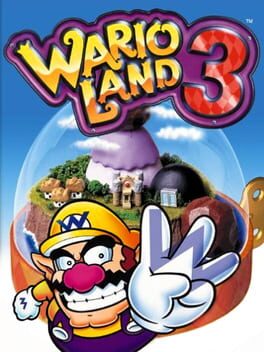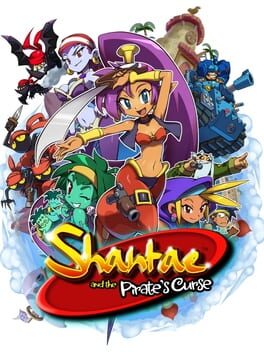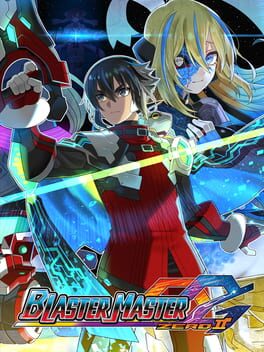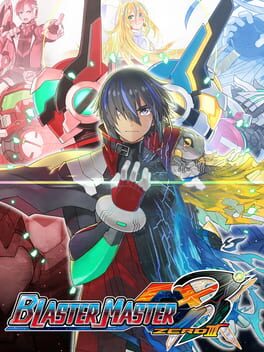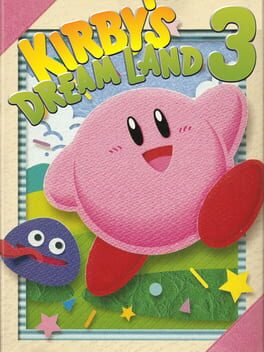DeltaWDunn
2000
I'll start with negatives: The way coins were handled. The only use they have is to play that dumb golf minigame (That I'll get to). I had 999 coins, the max amount, for a majority of the playthrough. Also, the 8 big coins in each stage reset if you don't collect them all. What do you get if you collect them all? Our friend from about 4 sentences ago, that dumb golf minigame.
The golf minigame isn't particularly hard or detrimental, but it's undeniably poorly designed. The courses seem random; Sometimes they were extremely hard, the next would be extremely easy. Many times you'd have to make a blind shot due to the strict number of shots and the Gameboy's poor visibility. It rarely took me more than three times to beat, but it's a shame that the only minigame in here is bad.
Anyway, let's get into the goods: The game keeps a lot from Wario Land 2. The unconventional 'powerups' and general moveset are the same. However, the general design and structure is very different. In Wario Land 3, you don't lose coins for getting hit. Instead, getting hit is usually punished with one of the 'powerups' or just getting knocked down from a platforming section. Like I said, coins aren't really that valuable here, so I'm fine with that (Although coins COULD'VE been more valuable in a game about Wario). This also let the creators experiment more with the level design. Here's an example: The spring powerup makes Wario constantly jump around for a while. This is a positive for certain platforming sections. However, it can be a negative if put in a bossfight with several platforms above it, because Wario will jump out of the arena in spring form and can't return easily. As such, a button to undo this powerup isn't an option, as it could ruin a boss' difficulty. This could mean the player would have to wait for Wario to exit spring form in many cases, which could be annoying. HOWEVER, spikes knock Wario out of spring form, and they're often conveniently placed near the spring powerup. So now, just like the spring, the spikes can be beneficial or detrimental depending on context. In my opinion, this is brilliant game design that challenges the player to always think about their surroundings and current state.
This doesn't even touch the non-linear structure with powerups earned overtime. That's right, Wario Land 3 is a Castleroid of sorts. I'm not gonna lie, having to wait a good third of the game before being able to pick up stuff irked me a bit after playing WL 1 and 2, but Wario Land 3 did what it needed to do with most of its powerups: Something interesting. Some were pretty unimpressive, like an upgraded charge, but the high jump, throwing, ground pound, and others are all pushed in interesting directions. I imagine the structure of this game would make replays vastly different, as there's a fork in which stages you can tackle pretty early on.
Honestly, I'm almost tempted to give this game a 9/10. However, it has some clear flaws, so an 8/10 for now. Play this game. Play every Wario Land game. The series gets better with every entry (Note: I haven't played Shake It!! yet).
The golf minigame isn't particularly hard or detrimental, but it's undeniably poorly designed. The courses seem random; Sometimes they were extremely hard, the next would be extremely easy. Many times you'd have to make a blind shot due to the strict number of shots and the Gameboy's poor visibility. It rarely took me more than three times to beat, but it's a shame that the only minigame in here is bad.
Anyway, let's get into the goods: The game keeps a lot from Wario Land 2. The unconventional 'powerups' and general moveset are the same. However, the general design and structure is very different. In Wario Land 3, you don't lose coins for getting hit. Instead, getting hit is usually punished with one of the 'powerups' or just getting knocked down from a platforming section. Like I said, coins aren't really that valuable here, so I'm fine with that (Although coins COULD'VE been more valuable in a game about Wario). This also let the creators experiment more with the level design. Here's an example: The spring powerup makes Wario constantly jump around for a while. This is a positive for certain platforming sections. However, it can be a negative if put in a bossfight with several platforms above it, because Wario will jump out of the arena in spring form and can't return easily. As such, a button to undo this powerup isn't an option, as it could ruin a boss' difficulty. This could mean the player would have to wait for Wario to exit spring form in many cases, which could be annoying. HOWEVER, spikes knock Wario out of spring form, and they're often conveniently placed near the spring powerup. So now, just like the spring, the spikes can be beneficial or detrimental depending on context. In my opinion, this is brilliant game design that challenges the player to always think about their surroundings and current state.
This doesn't even touch the non-linear structure with powerups earned overtime. That's right, Wario Land 3 is a Castleroid of sorts. I'm not gonna lie, having to wait a good third of the game before being able to pick up stuff irked me a bit after playing WL 1 and 2, but Wario Land 3 did what it needed to do with most of its powerups: Something interesting. Some were pretty unimpressive, like an upgraded charge, but the high jump, throwing, ground pound, and others are all pushed in interesting directions. I imagine the structure of this game would make replays vastly different, as there's a fork in which stages you can tackle pretty early on.
Honestly, I'm almost tempted to give this game a 9/10. However, it has some clear flaws, so an 8/10 for now. Play this game. Play every Wario Land game. The series gets better with every entry (Note: I haven't played Shake It!! yet).
Gameplay wise, it's not much different than any other Castleroid. There are islands multiple islands to explore, which are each their own separate maps. Each map is kind of structured like a section of a Zelda game: Explore the overworld, get access to the dungeon, gain a new ability, fight the boss, repeat. Just like Zelda, I'd say the dungeons are the highlight. Each one teaches you how to use your newly acquired ability well, and it blends platforming and action well. Many of the worlds can be completed without backtracking to another, although that's not always true, and backtracking is a good idea anyway because some areas can't be reached without a late game item. This, combined with a great balance between giving a general goal but not insulting the player's intelligence, gives the game a great sense of pacing for the most part.
Those abilities, however, are pretty basic. This may be due to the game being release right before the renaissance of the Castleroid genre, but still. Melee attacks, Ranged attacks, dashes, glides, and midair jumps, while fun, do make this game blend into the crowd in that regard. Axiom Verge, which released a year after this, had way more unique abilities (That game has its own issues, but that's a discussion for another time).
The only other gameplay note is how the items work, which I'm kind of mixed on. I like that each item maxes out at 9, so you can't spam healing items... too much. You also can't use items if you're prone or in the air. However, as long as you don't constantly spam items, you can easily steamroll bosses with monster milk and pike balls. I never took more than two attempts at a boss. Most other sections of the game don't have this problem either, because platforming sections start you over at the beginning of a room, so you can't really cheese them.
The biggest thing I was dreading going into this one was the story. However... I kind of liked it? I don't think it's great or anything, but it contextualizes the events well, and all of the ways in which the story lets you progress is really funny. I also like some of the characters. But yeah, this is still far from the peak of gaming storytelling, even for a game like this.
Visually, the game is great. Even if they're not all particularly unique (Bog island is really cool, but the others are mostly basic), all the locations look excellent, and so do the animations. The soundtrack is also really good, and each theme fits the area well.
Overall, a very good game. I don't know if I'll check out other games in this series, since I've heard this is the best one, but still. It could maybe become an 8, but a 7/10 for now.
Those abilities, however, are pretty basic. This may be due to the game being release right before the renaissance of the Castleroid genre, but still. Melee attacks, Ranged attacks, dashes, glides, and midair jumps, while fun, do make this game blend into the crowd in that regard. Axiom Verge, which released a year after this, had way more unique abilities (That game has its own issues, but that's a discussion for another time).
The only other gameplay note is how the items work, which I'm kind of mixed on. I like that each item maxes out at 9, so you can't spam healing items... too much. You also can't use items if you're prone or in the air. However, as long as you don't constantly spam items, you can easily steamroll bosses with monster milk and pike balls. I never took more than two attempts at a boss. Most other sections of the game don't have this problem either, because platforming sections start you over at the beginning of a room, so you can't really cheese them.
The biggest thing I was dreading going into this one was the story. However... I kind of liked it? I don't think it's great or anything, but it contextualizes the events well, and all of the ways in which the story lets you progress is really funny. I also like some of the characters. But yeah, this is still far from the peak of gaming storytelling, even for a game like this.
Visually, the game is great. Even if they're not all particularly unique (Bog island is really cool, but the others are mostly basic), all the locations look excellent, and so do the animations. The soundtrack is also really good, and each theme fits the area well.
Overall, a very good game. I don't know if I'll check out other games in this series, since I've heard this is the best one, but still. It could maybe become an 8, but a 7/10 for now.
I meant to buy the first Blaster Master Zero, but I somehow accidentally bought the second, so here I am.
Blaster Master Zero 2 is the second in a revival series of the NES game Blaster Master. It's kind of a Castleroid, but not really. While the game does indeed have a somewhat interconnected map and upgrades, there are several planets that you unlock in different levels. While there is interplanetary backtracking, very rarely will one be required to return to a planet after doing the main object (Unless you want the good ending, that is). Even so, the game never feels restrictive and does give freedom in how you tackle many of the missions. It also helps that the Tank sections are really fun. Most of the weapons are fun to use, and while movement options like Dashes, Wall Jumps, and Ground Pounds, and hovers are ridiculous to see a Tank do, they're pretty fun.
The Top-Down sections are good too, but I had a few issues. You see, in the Tank sections are pretty simple. The basic guns are your bread and butter. The special moves use gaia power, which is recharged by... jumping from a high place. It's pretty simple.
The Top-Down sections have the upgradeable blaster, a selection of grenades, and multiple counter moves. I think that there's a bit too much to deal with here. All of the 8 blaster settings are somewhat different, but I rarely felt compelled to use half of them. The same goes with many of the grenades. The counters are interesting and executed fairly well (Although I kinda wish the dash move was independent of it so I could use it without countering). Apparently Blaster Master Zero 3 simplified it with only one counter and Five Blaster Options with statistical upgrades, which sounds much simpler and funner.
Aside from that, these Top-Down sections are designed just fine, but they're pretty simple. There's really no moments where you have to use any unique powerups to progress, besides grenades breaking cracked walls. There are a few interesting level design gimmicks, but it's not as diverse or engaging as the Tank sections.
Obviously I didn't play the first game so I was kind of thrown into the story, and I can't say I'm too impressed. It's kind of neat that the other pilots you meet are references to Sunsoft titles, and they have fine enough personalities, but they aren't particularly special. I did like how occasionally gameplay mechanics were used to inform the story, such as how the gaia system was used near the end, but other than that, it's alright.
I'm definitely gonna check out the other games. It's a fun retro revival that I'm gonna give a 7/10.
Blaster Master Zero 2 is the second in a revival series of the NES game Blaster Master. It's kind of a Castleroid, but not really. While the game does indeed have a somewhat interconnected map and upgrades, there are several planets that you unlock in different levels. While there is interplanetary backtracking, very rarely will one be required to return to a planet after doing the main object (Unless you want the good ending, that is). Even so, the game never feels restrictive and does give freedom in how you tackle many of the missions. It also helps that the Tank sections are really fun. Most of the weapons are fun to use, and while movement options like Dashes, Wall Jumps, and Ground Pounds, and hovers are ridiculous to see a Tank do, they're pretty fun.
The Top-Down sections are good too, but I had a few issues. You see, in the Tank sections are pretty simple. The basic guns are your bread and butter. The special moves use gaia power, which is recharged by... jumping from a high place. It's pretty simple.
The Top-Down sections have the upgradeable blaster, a selection of grenades, and multiple counter moves. I think that there's a bit too much to deal with here. All of the 8 blaster settings are somewhat different, but I rarely felt compelled to use half of them. The same goes with many of the grenades. The counters are interesting and executed fairly well (Although I kinda wish the dash move was independent of it so I could use it without countering). Apparently Blaster Master Zero 3 simplified it with only one counter and Five Blaster Options with statistical upgrades, which sounds much simpler and funner.
Aside from that, these Top-Down sections are designed just fine, but they're pretty simple. There's really no moments where you have to use any unique powerups to progress, besides grenades breaking cracked walls. There are a few interesting level design gimmicks, but it's not as diverse or engaging as the Tank sections.
Obviously I didn't play the first game so I was kind of thrown into the story, and I can't say I'm too impressed. It's kind of neat that the other pilots you meet are references to Sunsoft titles, and they have fine enough personalities, but they aren't particularly special. I did like how occasionally gameplay mechanics were used to inform the story, such as how the gaia system was used near the end, but other than that, it's alright.
I'm definitely gonna check out the other games. It's a fun retro revival that I'm gonna give a 7/10.
Blaster Master Zero III kind of confused me. It fixed 2's biggest problem: The clutter of a toolkit in the Top-Down sections. In III, there's 5 guns (each of which upgrade individually), a selection of subweapons, a dedicated dash button, and a singular counter button. I also loved the risk-reward element that many of these dungeons had: risking your progress for even more upgrades, or playing it safe and leaving. The Top-Down sections still have problems; The progression isn't nearly as developed as in the 2D sections, the level design is still very basic and rarely makes use of all the moves, etc.... However, they were undeniably better than those of 2.
However, I think I prefer the 2D sections in 2 more than in III, for several reasons. 2 had much more level variety and felt like a much more streamlined yet still unique experience. In III, most of the locations are just cyber-hallways. The movement in 2 was also much better. You had a dash, a 'ground-pound' in the form of a drill, wall jumps, and deployable springs. III ditches the drill and springs, and has spawnable block lines. An interesting concept, but it's introduced near the very end and is underutilized.
I also wasn't a fan of the reverse dimensional rifts. It's an interesting idea: Flipping a game mechanic on it's head in fun ways. The issue is that often, the ways are not actually fun. I liked the enemies jumping when you touch a spring, but everything else was pretty forgettable. In Top-Down, the rifts are just auto-generated sections that aren't all that great.
That just reminded me of another thing that annoyed me. In the top-down sections, often you're presented with really tough enemies or constantly respawning enemies. However, fairly early on the game basically says, "Oh, just take the rifts to skip those." What? Why are you making a section intentionally annoying and encouraging the player to skip it in a game where scouring the map for collectibles is the whole point? There's nothing in said sections, so they are quite literally made to be skipped.
I know I've been ragging on this game, but I still enjoyed it more than I didn't. The visuals and sound are a bump from 2, the story is cheesy but somewhat entertaining, and most of the bosses are really good (Although a few were reused ones from previous games). However, a few dumb choices prevented this from being the true pinnacle of mutant-blasting action.
However, I think I prefer the 2D sections in 2 more than in III, for several reasons. 2 had much more level variety and felt like a much more streamlined yet still unique experience. In III, most of the locations are just cyber-hallways. The movement in 2 was also much better. You had a dash, a 'ground-pound' in the form of a drill, wall jumps, and deployable springs. III ditches the drill and springs, and has spawnable block lines. An interesting concept, but it's introduced near the very end and is underutilized.
I also wasn't a fan of the reverse dimensional rifts. It's an interesting idea: Flipping a game mechanic on it's head in fun ways. The issue is that often, the ways are not actually fun. I liked the enemies jumping when you touch a spring, but everything else was pretty forgettable. In Top-Down, the rifts are just auto-generated sections that aren't all that great.
That just reminded me of another thing that annoyed me. In the top-down sections, often you're presented with really tough enemies or constantly respawning enemies. However, fairly early on the game basically says, "Oh, just take the rifts to skip those." What? Why are you making a section intentionally annoying and encouraging the player to skip it in a game where scouring the map for collectibles is the whole point? There's nothing in said sections, so they are quite literally made to be skipped.
I know I've been ragging on this game, but I still enjoyed it more than I didn't. The visuals and sound are a bump from 2, the story is cheesy but somewhat entertaining, and most of the bosses are really good (Although a few were reused ones from previous games). However, a few dumb choices prevented this from being the true pinnacle of mutant-blasting action.
1997
Well then. I'm sure you all know Kirby (Or, at least, know of him). I certainly have for quite a while. Many people regard it as a series with no bad games. I would say that this game is clear evidence to the contrary.
From the Kirby games I've played, I've noticed that there's two ways to make the gameplay engaging:
1. Small sections that are built around a copy ability that can be easily obtained beforehand. These sections are fun and often reward the player for keeping the copy ability with lives or something else.
2. Pure combat sections in which the player can choose a copy ability to use. Fun here is derived from using varied moves to defeat a boss or something of the sort.
I haven't played every Kirby game, and I'm sure there's another way to make a Kirby game engaging, but regardless, a Kirby game needs to be accessible to children but still pique the interest of adults in some way. Kirby's Dream Land 3 does neither, and is an abject failure in being interesting in any way.
Copy abilities have regressed from Superstar into being the simple one-attack abilities from previous entries. This already greatly limits the potential of Kirby design #2. Not automatically an issue, as I think Kirby's Adventure on the NES is one of the best in the series, because it uses Kirby design #1. Levels feel best when using the copy abilities acquired in them, but are still beatable without them. However, would you believe me if I said Dream Land 3 had LESS THAN A THIRD of the copy abilities from Adventure? Once again, not automatically bad, as the animal buddies that help kirby actually change the way copy abilities are used. But there was one fatal mistake. Everything else aside, one thing doomed this game.
Around 80% of the time, the animal buddies are a worse option than just using Kirby by himself.
Imagine if you were playing as Yoshi in super Mario World, except Yoshi is a bit slower and can't jump as high as Mario. That is a rough equivalent of the animal buddies in Kirby's Dream Land 3. Kirby can float, so why would I use Riki, who can only jump once? Coo and Kine are slower than Kirby, so why use them? Even if one may fit a situation, you have to grapple with the altered copy abilities, which can be ridiculously niche in terms of use compared to Kirby's. The only one who was fairly consistently fun to use was Nago, because he was fairly fast, could jump two times in midair (Which was usually good enough), and usually had good copy abilities. The others are almost always detrimental to use in one way or another. Unfortunately, though, I didn't always get to use Nago, as there's usually only around half of the animal buddies in a given stage placed at checkpoints. Despite this, I rarely ever got the feeling that the levels were designed with the animal buddies in mind. Even when they're designed with copy abilities in mind, it's usually just 'hit this block with this copy ability to break it', the laziest way to do it.
There are several other issues. Kirby often outruns the camera, which results in enemies landing cheap shots. the level select and optional content is barebones compared to even Kirby's Adventure. Gooey, the player 2 character, is useless. The game loves autoscrolling sections for no reason. All of the secrets are super obscure and not fun to find. It only contributes even more to the low quality.
The biggest positive I can give this game is that it's a beautiful game. It has great style and animation. Everything else? Okay at best. This brings us back to the statement, "there are no bad Kirby games". Honestly, as bad as this game was, it was, at the end of the day, really easy. I rarely got actually frustrated as a result. However, I never got particularly happy playing it either. I rarely felt anything. Honestly, I think that's one of the worst things a game can be: Absolutely nothing. This game isn't legendarily bad; It's just... boring bad. And I'll probably never play it again.
From the Kirby games I've played, I've noticed that there's two ways to make the gameplay engaging:
1. Small sections that are built around a copy ability that can be easily obtained beforehand. These sections are fun and often reward the player for keeping the copy ability with lives or something else.
2. Pure combat sections in which the player can choose a copy ability to use. Fun here is derived from using varied moves to defeat a boss or something of the sort.
I haven't played every Kirby game, and I'm sure there's another way to make a Kirby game engaging, but regardless, a Kirby game needs to be accessible to children but still pique the interest of adults in some way. Kirby's Dream Land 3 does neither, and is an abject failure in being interesting in any way.
Copy abilities have regressed from Superstar into being the simple one-attack abilities from previous entries. This already greatly limits the potential of Kirby design #2. Not automatically an issue, as I think Kirby's Adventure on the NES is one of the best in the series, because it uses Kirby design #1. Levels feel best when using the copy abilities acquired in them, but are still beatable without them. However, would you believe me if I said Dream Land 3 had LESS THAN A THIRD of the copy abilities from Adventure? Once again, not automatically bad, as the animal buddies that help kirby actually change the way copy abilities are used. But there was one fatal mistake. Everything else aside, one thing doomed this game.
Around 80% of the time, the animal buddies are a worse option than just using Kirby by himself.
Imagine if you were playing as Yoshi in super Mario World, except Yoshi is a bit slower and can't jump as high as Mario. That is a rough equivalent of the animal buddies in Kirby's Dream Land 3. Kirby can float, so why would I use Riki, who can only jump once? Coo and Kine are slower than Kirby, so why use them? Even if one may fit a situation, you have to grapple with the altered copy abilities, which can be ridiculously niche in terms of use compared to Kirby's. The only one who was fairly consistently fun to use was Nago, because he was fairly fast, could jump two times in midair (Which was usually good enough), and usually had good copy abilities. The others are almost always detrimental to use in one way or another. Unfortunately, though, I didn't always get to use Nago, as there's usually only around half of the animal buddies in a given stage placed at checkpoints. Despite this, I rarely ever got the feeling that the levels were designed with the animal buddies in mind. Even when they're designed with copy abilities in mind, it's usually just 'hit this block with this copy ability to break it', the laziest way to do it.
There are several other issues. Kirby often outruns the camera, which results in enemies landing cheap shots. the level select and optional content is barebones compared to even Kirby's Adventure. Gooey, the player 2 character, is useless. The game loves autoscrolling sections for no reason. All of the secrets are super obscure and not fun to find. It only contributes even more to the low quality.
The biggest positive I can give this game is that it's a beautiful game. It has great style and animation. Everything else? Okay at best. This brings us back to the statement, "there are no bad Kirby games". Honestly, as bad as this game was, it was, at the end of the day, really easy. I rarely got actually frustrated as a result. However, I never got particularly happy playing it either. I rarely felt anything. Honestly, I think that's one of the worst things a game can be: Absolutely nothing. This game isn't legendarily bad; It's just... boring bad. And I'll probably never play it again.
